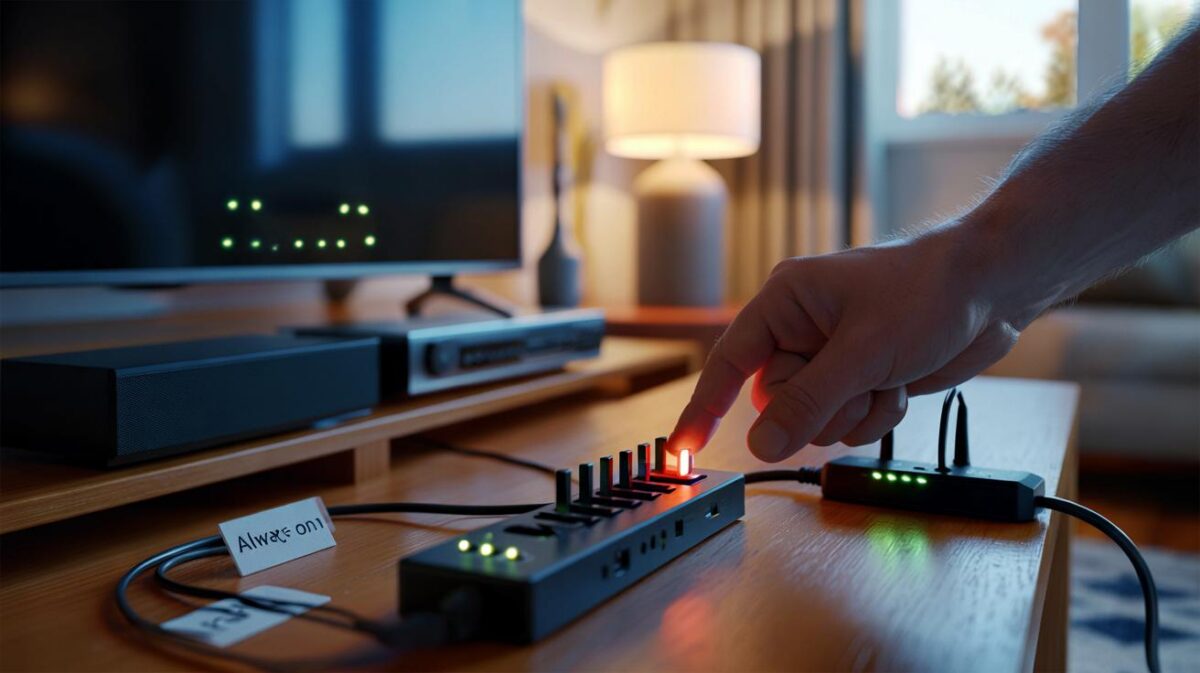The phone it feeds is somewhere else now, in a bag or a pocket or on the sofa under a cushion. Yet the charger remains, humming through the day nobody hears, sipping power you don’t see on any screen. In the kitchen, a red LED glows beside the kettle. The hallway extension drapes like ivy, LEDs along its spine like a little runway of waste. Neat lives create messy habits. We tidy the cables out of sight and forget the vampire at the wall.
The truth about “vampire” chargers
We’ve all had that moment when you clock the lonely charger and wonder if it’s quietly costing you a fortune. The short answer: a single modern phone charger left plugged in with no phone attached uses very little power. Think 0.05–0.1 watts for many reputable models. That’s a sliver, almost a rounding error day to day. Leave it on for a whole year and you might burn through roughly 0.44–0.88 kWh. At a typical UK unit rate around 28–30p per kWh, you’re looking at pennies, not pounds.
Zoom out and the picture shifts. A laptop brick idling can draw 0.2–1 watt, sometimes more on older designs. A tangled family collection of ten mixed chargers—phones, tablets, a smartwatch dock, two laptop bricks—might quietly add 2–5 watts around the clock. Over a year that’s 17.5–43.8 kWh. At 30p per kWh, the bill ranges from about £5.25 to roughly £13.14. Not headline-grabbing, yet not nothing either, especially when bills already sting.
Here’s the logic in plain English. Multiply the watts by hours, divide by 1,000 to get kWh, then multiply by your tariff. A 0.1-watt phone charger: 0.1 × 8,760 hours = 876 watt-hours = 0.876 kWh. On 30p, that’s ~26p a year. Swap in an older 1-watt brick: 1 × 8,760 = 8.76 kWh ≈ £2.63 per year. **The big swings come from how many chargers you leave in, and how old or cheap they are.** If you keep three laptop bricks and five old phone adaptors permanently parked, you could be gifting the grid the price of a takeaway, every single year.
What to do today, tomorrow, and for good
Start simple. Unplug the lone bricks you don’t use daily and move “active” chargers to a switchable power strip. Then flick off the strip when nothing is charging. If you like a little automation, a cheap smart plug can cut power on a schedule—say, off at midnight, back on at 6 a.m. Place a basket by a single, well-lit socket and make it the home for nightly charging. **One small ritual beats hunting for seven stray cables across four rooms.**
Let’s be honest: nobody actually does that every day. So design for the person you are on a Thursday night, not the Sunday-best version of yourself. Label laptop bricks with a bit of tape so the culprit is easy to spot. Make the sockets you see the ones you switch, and hide the rest. *I still catch myself leaving the tablet charger in, only remembering when I see the red wink of the extension in the dark.* A visible switch is a tiny nudge; hundreds of nudges save pounds.
Old, hot, or bendy-cable chargers are worth retiring outright. Cheap, unbranded cubes often sip more when idle and age faster. That tiny warmth you feel is energy seeping into nothing—and a hint your kit’s past its best. Replace with a reputable, efficiency-rated charger. You’ll save a bit of energy and lower the already small risk of a cable fault.
“Think of always-on chargers as crumbs under the table. One isn’t a meal, but a hundred across the year is a slice of your bill,” says Mark Patel, an energy auditor who measures home standby loads for a living.
- Modern phone charger left in: roughly 20–30p per year.
- Old 1-watt charger: about £2.50–£3 per year.
- Mixed family bundle (10 chargers, 2–5 watts total): £5–£13 per year.
- Smart plug schedule: convenience first, savings as a bonus.
- Safety boost: retire damaged or hot chargers and avoid cheap no-name bricks.
So, what could you really save?
Here’s a grounded yardstick. If you prune the dead weight—say, retire three old 1-watt chargers and put the rest on a switchable strip—you might trim 15–25 kWh a year. On a 30p tariff, that’s £4.50–£7.50. Add two older laptop bricks into that cull and the saving nudges £10–£15. Not life-changing. Though stack it with other quiet wins—turning off the TV box overnight, taming the always-on printer—and your “phantom” cuts can top £60 across a year. **Small switches feel pointless in isolation; in numbers, they’re momentum.** Share your number: how many chargers can you bench tonight?
| Point clé | Détail | Intérêt pour le lecteur |
|---|---|---|
| Realistic per-charger cost | Modern phone chargers ~0.05–0.1W idle ≈ 20–30p/year at 30p/kWh | Stops fear, sets true expectations |
| Where savings grow | Bundles of older bricks and laptop adaptors can add 2–5W 24/7 | Shows how small loads add up across a home |
| Action that sticks | Switchable strips, smart-plug schedules, retiring hot/cheap chargers | Easy steps that blend into daily life |
FAQ :
- How much does leaving a phone charger plugged in cost per year?For a modern, efficient phone charger with nothing attached, around 20–30 pence a year at roughly 30p per kWh. Older or low-quality chargers can be £2–£3 each.
- Do chargers use power when a device is fully charged?Yes, but very little. Most decent chargers and phones taper down to a trickle. The draw is small, though keeping the charger in the wall still adds a modest standby load.
- Are laptop chargers worse than phone chargers?Often, yes. Many laptop bricks idle at 0.2–1 watt, sometimes more for old models. That can mean £1–£3 per year each if left in 24/7, plus a bit of heat and cable wear.
- Is it safer to unplug chargers when not in use?It reduces risk slightly. Quality chargers are designed to be safe, yet damaged cables, dust, or cheap, unbranded units are weak links. Unplugging cuts both standby consumption and rare fault chances.
- What’s the quickest way to cut “vampire” costs?Group chargers on one switchable strip and flip it off when you’re done. Retire hot or no-name chargers. If you like automation, set a smart plug to sleep overnight and wake before you do.








